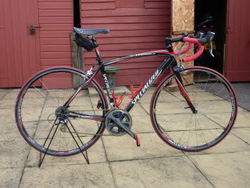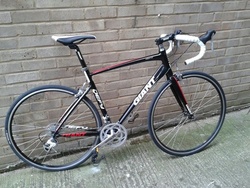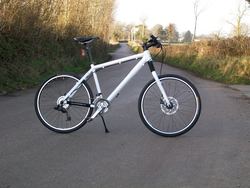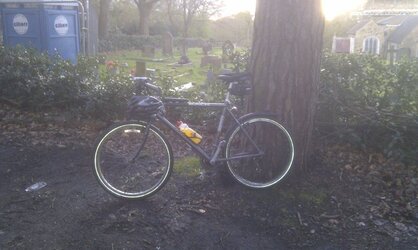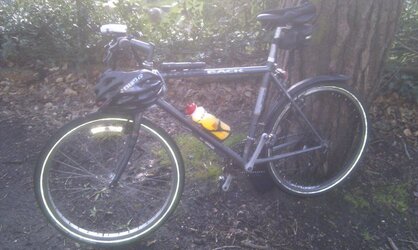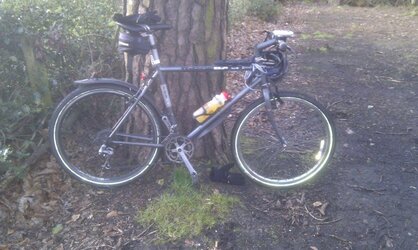You are using an out of date browser. It may not display this or other websites correctly.
You should upgrade or use an alternative browser.
You should upgrade or use an alternative browser.
show us your aluminium
- Thread starter Rohloff_Brompton_Rider
- Start date
Page may contain affiliate links. Please see terms for details.
The vienetta shape on the RHS is when they squeeze the first billet through the tool for the first time and these tools sit in a massive 2500 tonne press, and the design isn't quite right (some bits flow faster than others, and they employ full time tool corrector to fettle the tools to run properly). The 3 profiles lined up in front are sections of the profiles sawn mid length. Most ally bits on bikes start life in this way (I think these are some sort of structural profiles though) It is like a giant playdough machine
Well you said show us your ally

Thread hijack.... but quick question..... How do you extrude the hollow bits?
Linford
Guest
Thread hijack.... but quick question..... How do you extrude the hollow bits?
The Dies which produce the hollow profiles have 2 functional pieces called the Mandrel and Die plate.

They are designed to fit together to fill the hole in the press which the ally log (billet) is pushed against. The mandrel has a bit called the 'core' which dangles down into aperture in the die plate. part of the design between these 2 pieced is called a welding chamber where the ally after being split into the various different shaped 'ports' gets squeezed back together under enormous pressure (the extrusion presses can exert (up to) roughly 25 tonnes per square inch). The ally then flows through the gap shape between the core and die plate called 'bearings' of friction bearing surfaces (where you can see daylight in the pic above) and what comes out the back is the extruded profile. This is why when you look closely at ally tubing, you can normally see very slight marking equally spaced around the diameter. these are called the weld marks and come from the process of splitting and rewelding in the die.
Ally flows at different rates according to the shape and size of the ports, and also according to how thick the profile walls as well as whether the extrusion shape is in direct flow (line of sight) or obscured by the design required to support the core, are so the tools are designed to speed the ally up and slow it down in places so it all comes out ofthe back at the same rate.
We work to a set of rules, but every new die is effectively a prototype, and it is down to the die designer (me) to try and come up with something which extrudes quickly with minimal weld marking, and also is stable and balanced so the cores don't push over and produce uneven wall thicknesses. The tools can flex as well which can speed parts of the profile up, or the bearings can be inadequate to hold the fast bits in check. The extruders themselves who operate the presses can be anywhere in the world and employ people called die correctors who tickle the designs to ensure that they run properly (if they don't first time) The rippling in those particular profiles were caused by the original design being slightly off, and then compounded by the corrector at the press getting his arse around his elbow and compounding the problem instead of correcting it (which is why we have them and they came back along with the die so we could figure out from their shape what went wrong and adjust the tool to get the correct result)
Tubing for bike frames is only one type of profile shape, but extrusion is by far the cheapest way of getting ally (or brass/copper/magnesium etc) into the right shapes, and that is why the process is used so often to work the metal.
You did ask

Linford
Guest
You can learn the basic rules of engineering, but this sort of stuff isn't taught in any Uni, and we are constantly tweaking the design rules to give what the customers want. I came from an engineering co as a machinist producing stuff for the military and aerospace, did 7 years on the shop floor in this business before retraining in the design, and have been doing so now for 18 years (and am the least experienced in the design side in the office) and whilst some of the manufacturing part is a bit hammer and chisel, other parts where it counts is ultra precision using spark erosion machines which they prototype F1 car components with (bloody handy from time to time for our own 'projects'  )
)
When a product manufacturer (like a cycle maker) goes to an extruder with anything tricky, they will only agree to become contractually bound to supply after speaking to us and either asking we guarantee or not. In terms of end use, most is architectural like windows, doors, inner profile stiffeners for UPVC systems, security screens in banks, but have done tooling to produce heat sinks for CPU's, water to oil heat exchangers for the Saab Gruppen, profiles for airframes, lightweight armaco for the new severn crossing as steel was too heavy, Thule roofrack profiles, car bumpers, Lotus Elise chassis profiles etc etc. This list is endless and only bound by the manufacturers imagination (and of course whether we choose to guarantee the tool )
)
 )
) When a product manufacturer (like a cycle maker) goes to an extruder with anything tricky, they will only agree to become contractually bound to supply after speaking to us and either asking we guarantee or not. In terms of end use, most is architectural like windows, doors, inner profile stiffeners for UPVC systems, security screens in banks, but have done tooling to produce heat sinks for CPU's, water to oil heat exchangers for the Saab Gruppen, profiles for airframes, lightweight armaco for the new severn crossing as steel was too heavy, Thule roofrack profiles, car bumpers, Lotus Elise chassis profiles etc etc. This list is endless and only bound by the manufacturers imagination (and of course whether we choose to guarantee the tool
 )
)Lotus Elise chassis profiles)
So you may have made the chasis for my old VX220!
;-)
Psyclist
Über Member
- Location
- Northamptonshire
Muddyfox
Guru
- Location
- Blackdown Hills Devon
uphillstruggler
Legendary Member
- Location
- Half way there
old and tired Ridgeback 604LT but still a great bike to ride. original parts except the bottom bracket, saddle and rear wheel (a car reversed out of a drive and managed to ruin the rear wheel)
took it out last night as its the only bike i have with mud guards still fitted and i didnt have time to put the cruds back on the Giant.
I dont think i have even changed the cables and it still all works.
note to self - strip down and service.
took it out last night as its the only bike i have with mud guards still fitted and i didnt have time to put the cruds back on the Giant.
I dont think i have even changed the cables and it still all works.
note to self - strip down and service.
Attachments
Psycolist
NINJA BYKALIST
- Location
- North Essex
With the awful weather we had today I had nowt better to do so thought I would stick a pic up

Psycolist
NINJA BYKALIST
- Location
- North Essex
Ahhhhh The human condition......... I would commit all sorts of nasties for a clean ally frame like this, but you wanna swap to STEEL. Why is that a greener field than this beauty.Here's mine, but soon to be replaced by a Steel Frame I think...




